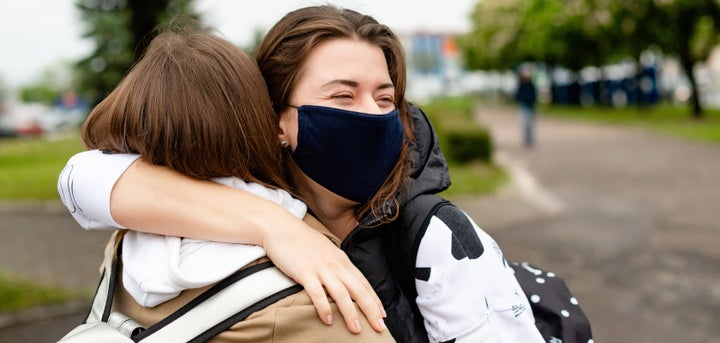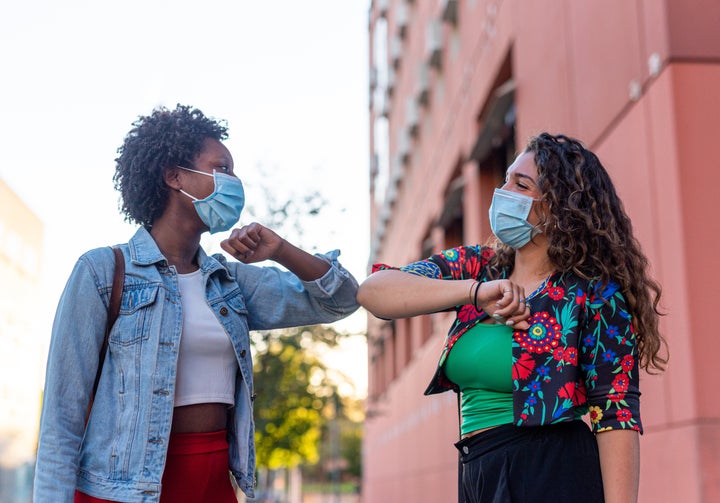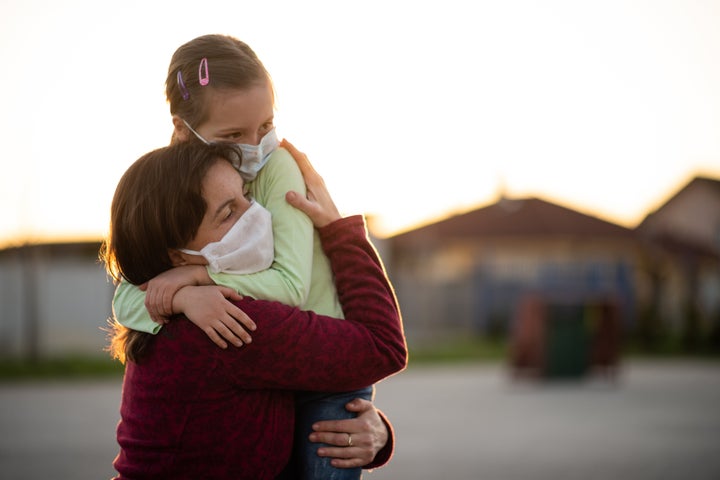Of the many things we miss from our pre-pandemic lives, hugging may top the list. And, as we continue to navigate the new rules and regulations around lockdown easing, we’re having to learn new ways to connect and socialise.
With people making up for lost time with long-overdue catch-ups, the question on everyone’s minds is: “Are we allowed to hug friends and family now?”
In Boris Johnson’s recent briefing, he reiterated that we should still keep a distance from people outside our household bubbles – even if they are your close friends. But it’s tough, we know.
Last week, I caught up with a friend in the park for the first time since March. We greeted one another with an elbow, but after a bottle of wine between us, naughtily ended up clutching each other in a longing embrace as we said our goodbyes. It felt like a jolt of electricity to be able to touch someone else – even if I did feel guilty afterwards.
The thing is, I know I’m not the only one who’s been accidentally handing out free hugs.

Why do we feel the need to hug?
The simple pleasure of being able to press one’s body onto someone else’s and have that human touch can bring joy to our lives. “We’re sociable beings,” says Lisa Johnston, cognitive behavioural therapist and director of My Therapist Online, “at times of trouble we seek comfort from others.”
“Humans benefit from touch,” she says, “and a hug can help to calm our threat system. When we hug, we experience decreased heart rate, higher levels of ‘feel-good hormones’ such as oxytocin, serotonin and dopamine as well as a reduction in cortisol levels.”
Johnston says we’re “at our best” when we feel connected with others.
But, is hugging good or bad right now?
For months we’ve been practising social distancing. Not being able to see or hug loved ones has been one of the biggest emotional tolls on people during the pandemic. Hugging is still not risk-free. Surprisingly, the risk of catching something during a brief hug can be pretty low, but if the person we want to hug is high risk – or either person has any symptoms – a hug should be avoided.
“There’s the combination of being in close proximity with someone and having increased breathing of the same air, so to speak,” Dr Adam Boies, expert in Nanomaterials and Aerosol Engineering at University of Cambridge tells HuffPost UK.
So technically, we can’t hug. But, adds Boies: “Ultimately, this kind of thing boils down to granular detail of how we live our lives and what we do. We don’t calculate risk matrices in our heads when we interact with loved ones. Hugging is risky behaviour, but it can be mitigated by wearing masks, keeping the encounter brief, avoid facing each other and washing hands after interaction.”

What about elbow bumps or foot taps?
While reducing the natural frequency of physical contact with others, Johnston says it’s important we explore other ways of feeling supported and connected. So how do we interact with each other in a way that keeps us safe but doesn’t offend? Smile with your eyes while wearing a mask, wave, thumbs up, elbow bump, feet tap, secret air handshake, bow?
Greetings can be replaced with other, non-contact behaviours such as a friendly smile, good eye contact and warm greetings or gestures, she says. “But there’s a place where we are naturally drawn to offering a hug to another as a way of communicating support, comfort, love and a closer connection to someone who needs it.”
What if you’re offered an unwanted hug?
Not everyone feels the same about hugging. Social psychologist and author of the Psychology of Wellbeing, Dr Gary Wood, says the pandemic has made some of feel us less touchy-feely – while hugging is often portrayed as an affectionate thing, it can also be triggering and crossing the line for others.
“Some people are keen huggers and assume it’s okay to automatically hug,” he says. “But the way we’ve been communicating is causing some of us to be more reflective and more creative.”
What do you do when someone comes swooping in for a hug, then? Do you... a) swat them away like a fly; b) accept it without your consent; or c) politely decline and squirm at the awkward silence that suddenly fills the air?
Recognise it’s a bizarre situation, says Wood, approach each other and ask: “Okay, what do we do instead?”

Or, if you’re the one who intends to go in for a hug, Wood adds: “In that situation, simply break the ice and ask if they’re comfortable. Lots of people just dive in and start hugging people. It’s important to respect people’s boundaries. Do people want to be hugged? Do we have the right to go up to start hugging people willy nilly? Who decides on the whole thing of body autonomy?”
Ultimately, you need to address and acknowledge the awkwardness – and decide whether a hug, in that situation, is safe and needed.
When will we *officially* be able to hug again?
This is likely to be when social distancing is dropped completely, which – when we asked the experts – isn’t easy to answer. It’s likely to be until there’s high enough levels of immunity in the population for distancing to be unnecessary.
